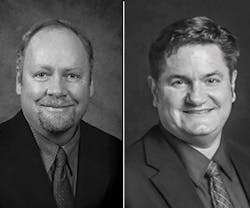Don't Overlook Operational Efficiencies in Your Data Center
BUILDINGS editor Chris Olson talked with Vice President Bill Younger of Energy Performance Services and Michael Stachowiak, Senior Energy Engineer V, both with CLEAResults, an energy efficiency consulting firm.
A data center’s first priority is its high-tech server hardware, yet to be efficient, operators also need to focus on facility maintenance. What is often overlooked?
Stachowiak: A general concern is that IT and facilities people may be divided into camps that do not communicate regularly unless there are problems. Because each focuses on its part of the business, they may not be in touch with each other on shared goals and possible solutions. Sometimes they even mistrust each other.
How do you remedy that situation?
Stachowiak: Upper management has a role to play here. Executives should recognize the cost savings and performance benefits that are possible from the two working together and create a culture where it is expected. The result can be fewer equipment failures, increased uptime and capacity, and lower IT and facility costs.
Younger: Once you solve a problem that has a benefit to both sides, you often start changing the culture, one solution at a time. For example, IT people may not know that the underfloor plenum is a big duct. For example, if you help them to clean up the plenum by removing unnecessary cabling, and improved airflow stops an overheating server from setting off alarms, both sides are happy. Even though newer data centers usually have their cables trays overhead, you still find unused cabling under the floor.
What are the factors involved in good air flow management?
Stachowiak: Cable management is a big part of air flow management because cabling obstructs air flow. Unused or unorganized cabling under a raised floor can severely restrict the flow of ventilation, which increases the demand for fan energy and degrades cooling performance. Also, the cabling behind servers is a potential obstruction for air, which moves from the cold aisle, which is usually in front of the server racks, across the server to the hot aisle behind the racks.
IT personnel focus first on their equipment and whether it is operating correctly. They may not think about the impact that air flow has on energy. And they may not be responsible for the energy bill – in fact, they may not even see it.
Younger: When servers are taken out of a rack, it is important to put in a blanking panel. Otherwise air from the cold aisle can short circuit through the empty server slot to the hot aisle without doing any useful work.
Stachowiak: Basically you want to avoid instances where a single hot spot is causing an entire center to be overcooled. For example, if a fan fails inside a server or the airflow is obstructed by cabling behind it, you want to address the hot spot only rather than lower the temperature throughout the facility, which wastes a lot of energy. We take in an infrared imager so we can see any hot spots.
Where else can ventilation air leak or be obstructed?
Younger: Be aware of the floor tile itself as well as the underfloor plenum. Perforated tiles in cold aisles should not be obstructed by other equipment, chair mats or desks. Also, floor grommets should be used to maintain air flow patterns wherever there are penetrations for cabling coming up through the floor.
Also, be aware of covering your unused CRAC units. Cold underfloor air can backflow out the top of these units if they are not covered.
What about server consolidation and virtualization? How do they help to increase energy efficiency?
Younger: Consolidation refers to running different applications on the same server. This can be more efficient in terms of utilization than a one app/one server approach. If a lot of individual servers are working at part loads, they will draw more power than a smaller number of servers operating at higher loads. Virtualization optimizes memory space and creates virtual servers to make it easier to segregate and manage applications.
Whenever servers are consolidated, take unused units out of the rack. This ensures that the servers cannot draw electricity or be powered on accidentally. Then install blanking panels on all empty server slots.
What do operators need to monitor to maintain peak efficiency?
Stachowiak: Server utilization should be monitored because a department within an organization might discontinue using a particular application, resulting in an underutilized server that no one knows about.
Younger: Monitor power loads and HVAC temperatures throughout the space. For example, lower supply temperatures from CRAC units may indicate hot spots that should be identified. When new equipment is added, the facilities department should work with the IT department to ensure that air flow is adequate. This may mean adjusting fan speeds or moving floor tiles. Many newer servers can tolerate higher temperatures than older units, and it is possible that temperature setpoints can be raised to reduce energy costs.
Stachowiak: And don’t forget air filter replacement. The easiest way to do this is by installing a magnehelic gauge on the filter. These cost as little as $20 and will notify you if dirt is causing a pressure differential across the filter.
